run flat AUDI Q7 2014 Owner´s Manual
[x] Cancel search | Manufacturer: AUDI, Model Year: 2014, Model line: Q7, Model: AUDI Q7 2014Pages: 340, PDF Size: 85.02 MB
Page 50 of 340

48 Openin g and clo sing
- As soon as the electrical connec tion to
the trailer socket is completed on
vehicles with a factory installed towing
hitch, or a trailer hitch that was installed
later according to factory specifications,
the automatic rear lid function can only
be operated v ia the handle in the rear lid.
Rear lid emergency unlocking
If the rear lid cannot be opened, an emergen
cy release is provided .
1----------------- --,l~ N
Fig . 4 1 Section of the luggage compar tment : Access to
emerge ncy re lease
Fig . 42 Sect ion of the luggage compartment: Emer
gency release
,.. Tilt the seatback forward.
,.. Move into the t runk.
,.. Take the s crewdriver from the veh icle tool
kit. As an alternat ive, you can a lso use the
vehicle key.
• Put the flat side of the screw driver into the
recess and pry the cover up
o fig. 41 -Arrow-.
• Press the lever in the direction of the arrow
o fig . 42 to unlock the rear lid .
Child safety lock
Power child safety lock for the rear
doors
The power child safety lock t prevents the
rear doors from being opened from the in
side .
Fig . 43 Sect ion fro m driver's door: controls
The rear doors are equipped with a power
child safety lock.
It is operated with the two
safety buttons
III in the dr iver's door o fig. 43.
• Press the left and/or right safety button to
disab le the rear power window(s) and pre
vent the respective rear door from being
opened from the inside. The LED in the but
ton will light up when the child safety lock is
turned
on .
,.. Press the illum inated button again to turn
the child safety featu res
off .
When the c hild safety lock is activated, the in
te rior door opening lever is inoperative; the
doo r can only be opened from th e outside. In
addition, the window reg ulator for that doo r
is also inoperative when the child safety lock
is activa ted.
If the child safety lock has been ac tivated on
one or both sides, the butto ns in the rear for
the Panoramic slid ing su nroof* are disabled .
If the child safety lock has been act ivated on
the left
and on the right side, the rear con
tro ls are locked on veh icles with rear a ir-condi
tion ing *. Dashes" ••• " are show n in t he dis
plays for the rear climate contro ls, and the
rear air-conditioning can on ly be operated
from the climate controls in the cabin
opage 98.
Page 157 of 340

Adaptive Air Suspension
Air suspension and damping
Description
App lies to vehicles: with Adapt ive Air S uspe nsio n
Air suspension and damping con be adjusted
separately.
Adaptive A ir Suspension is an electronically
controlled springing and damping system.
This chassis system makes it easier on the
driver by adapt ing to the particular situation
through imperceptible control processes.
The
Adaptive Air Suspension component reg
ulates ground clearance depending on vehicle
speed and driver input. It functions independ
ently from the load condition . Accelerating to
a speed above a predetermined limit will make the vehicle lower itself. On the other
hand, driving more slowly results in the vehi
cle raising again at specific speeds.
The
damping component provides individual
control of the damping forces . For example,
w ith damping characterist ics set to provide
greater comfort, damping is set somewhat
harder for a br ief per iod only as required, for
example, when go ing aro und a curve or when
braking.
Settings
Adapt ive Air Suspension prov ides the driver
with the opportun ity to set the chassis charac
ter istics also to their individual preference.
W ith the driving modes
Comfort, Automatic
and Dynamic the driver has three chassis set
tings available, ranging from comfort to spor
ty. The
Offrood mode can be selected for driv
ing on poor quality stretches of road. In addi
tion,
Lift provides a fifth mode, which can be
selected when exceptionally high ground
clearance is needed
c::;, page 155, Chassis con
trols .
The modes are set in MMI <::;,page 157.
Adaptive A ir Suspension 155
A WARNING
The height of the parked vehicle can
change due to temperature fluctuations or
changes in load .
@ Note
- Whenever you park your vehicle, a lways
make sure there is adequate clearance
above and below the vehicle. The he ight
of the parked vehicle can change as the
result of temperature fluctuations,
changes in load condition and changes in
the driving mode (ground clearance).
- If the vehicle is being transported (e.g .
by tow truck, train, ship, etc.), mount the
tie-down chains/cables over the running
surface (circumference) o f the tires. Nev
er secure the vehicle by the axle, the sus
pension struts or the front or rear tow
line eye . For technica l reasons, the pres
sure in the suspens ion struts may change
during the transport, which could result
in the vehicle no longer being secured
properly .
- If you are going to tow a trailer with a
trailer hitch that was
not installed ac
cording to factory specif ications, you
must activate the traile r operation mode
man ually
<::;,page 159.
(D Tips
-Before you can raise your vehicle using
the vehicle jack (for example, when
chang ing a flat tire) or a vehicle lift, yo u
must activate the jacking mode
c::;, page 159.
- On some models, the vehicle can reach
its maximum speed only in the
Automat
ic
and Dynamic modes.
Chassis controls
App lies to vehicles : wit h Adaptive A ir Suspensio n
Five different driving modes can be set by the
driver.
T he automatic control processes are speed
and t ime-dependent. For example, it is not
Page 243 of 340
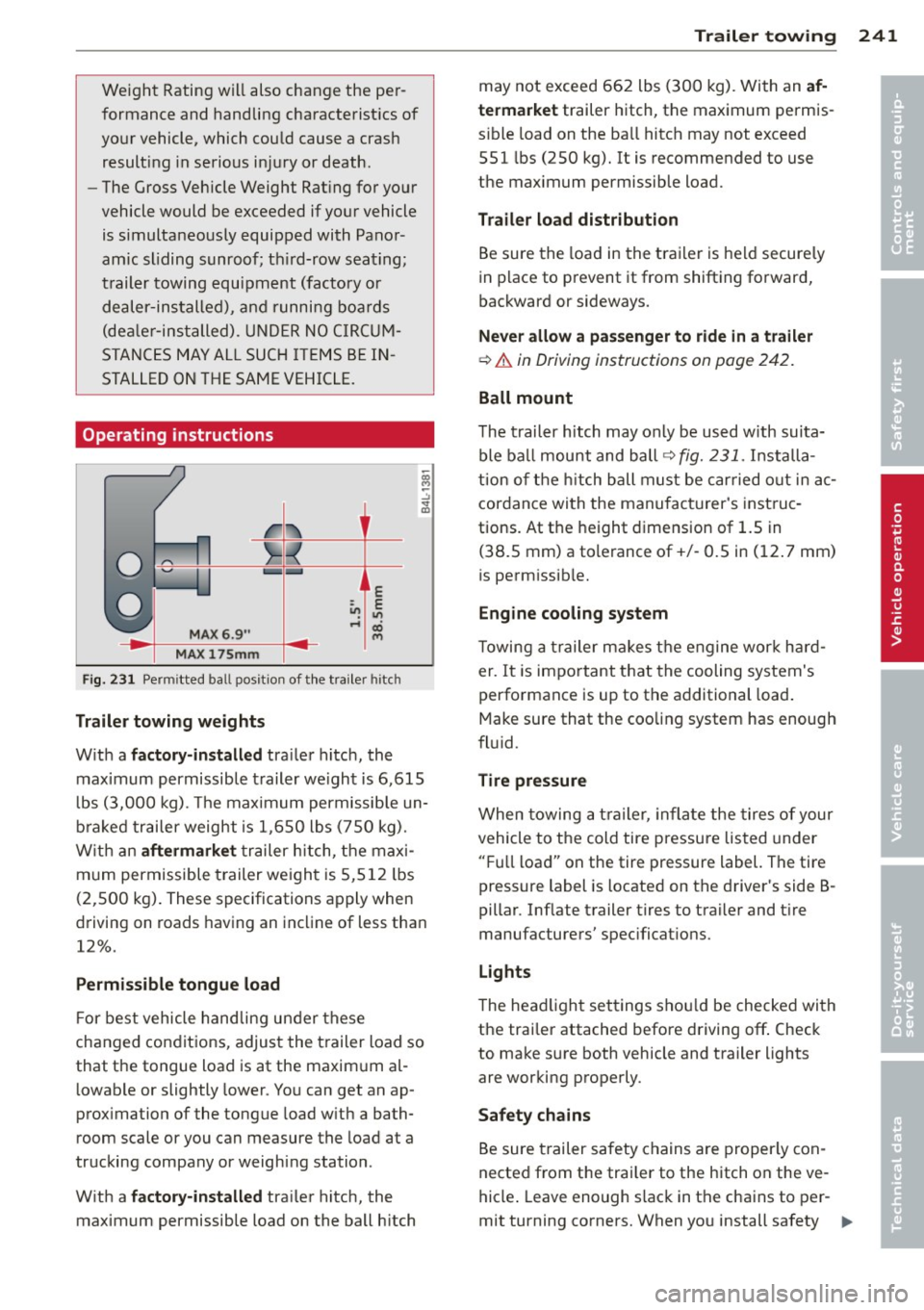
Weight Rating will also change the per
formance and handling characteristics of
your vehicle, which could cause a crash resulting in serious injury or death .
- The Gross Vehicle Weight Rating for your
vehicle would be exceeded if your vehicle
is simultaneously equipped with Panor
amic sliding sunroof; third-row seating;
trailer towing equipment (factory or
dealer-installed), and running boards
(dealer-installed) . UNDER NO CIRCUM
STANCES MAY ALL SUCH ITEMS BE IN
STALLED ON THE SAME VEHICLE.
Operating instructions
MAX 6.9"
MAX175mm
E
1/1 E 1/1 ... a)
m
Fig. 231 Perm itted ba ll posit ion of the trailer hitch
Trailer towing weights
With a factory-installed trailer hitch, the
maximum permissible trailer weight is 6,615
lbs (3,000 kg). The maximum permissible un
braked trailer weight is 1,650 lbs (750 kg).
With an
aftermarket trailer hitch, the maxi
mum permissible trailer weight is 5,512 lbs
(2,500 kg). These specifications apply when
driving on roads having an incline of less than
12%.
Permissible tongue load
For best vehicle handling under these
changed cond itions, adjust the trailer load so
that the tongue load is at the maximum al
lowable or slightly lower. You can get an ap
proximation of the tongue load with a bath
room scale or you can measure the load at a
trucking company or weighing station .
With a
factory-installed trailer hitch, the
maximum permissible load on the ball hitch Trailer towing 241
may not exceed 662 lbs (300 kg). With an
af
termarket
trailer hitch, the maximum permis
sible load on the ball hitch may not exceed
551 lbs (250 kg).
It is recommended to use
the maximum permissible load.
Trailer load distribution
Be sure the load in the trailer is held securely
in place to prevent it from shifting forward,
backward or sideways.
Never allow a passenger to ride in a trailer
¢ .& in Driving instructions on page 242.
Ball mount
The trailer hitch may only be used with suita
ble ball mount and ball ¢
fig. 231. Installa
tion of the hitch ball must be carried out in ac
cordance with the manufacturer's instruc
tions. At the height dimension of 1.5 in
(38.S mm) a tolerance of+/- 0.5 in (12. 7 mm)
is permissible.
Engine cooling system
Towing a trailer makes the engine work hard
er . It is important that the cooling system's
performance is up to the additional load.
Make sure that the cooling system has enough
fluid .
Tire pressure
When towing a trailer, inflate the tires of your
vehicle to the cold tire pressure listed under
"Full load" on the tire pressure label. The tire
pressure label is located on the driver's side B
pillar . Inflate trailer tires to trailer and tire
manufacturers' specifications .
Lights
The headlight settings should be checked with
the trailer attached before driving
off. Check
to make sure both vehicle and trailer lights
are working properly .
Safety chains
Be sure trailer safety chains are properly con
nected from the trailer to the hitch on the
ve
hicle. Leave enough slack in the chains to per
mit turning corners. When you install safety
Ill-
•
•
Page 289 of 340

-All four wheels must be fitted with radial
tires of the same type, size (rolling cir
cumference) and the same tread pattern .
Driving with different tires reduces vehi
cle handling and can lead to a loss of
control.
- If the spare tire is not the same as the
tires that are mounted on the vehicle -
for example with winter tires -only use
the spare tire for a short period of time and drive with extra care. Refit the nor
mal road wheel as soon as safely possi
ble.
- Never drive faster than the maximum
speed for which the tires on your vehicle
are rated because tires that are driven
faster than their rated speed can fail
suddenly.
- Overloading tires cause heat build-up,
sudden tire failure, including a blowout
and sudden deflation and loss of control.
- Temperature grades apply to tires that
are properly inflated and not over or un
derinflated .
- For technical reasons it is not always
possible to use wheels from other
vehicles -in some cases not even wheels
from the same vehicle model.
- If you install wheel trim discs on the ve
hicle wheels, make sure that the air flow
to the brakes is not blocked. Reduced air
flow to the brakes can them to overheat,
increasing stopping distances and caus
ing a collision.
- Run flat tires may only be used on
vehicles that were equipped with them at the factory. The vehicle must have a
chassis designed for run flat tires. Incor
rect use of run flat tires can lead to vehi
cle damage or accidents. Check with an
authorized Audi dealer or tire specialist
to see if your vehicle can be equipped
with run flat tires. If run flat tires are
used, they must be installed on all four
wheels . Mixing tire types is not permit
ted.
Tires and wheels 287
@ Note
- For technical reasons, it is not generally
possible to use the wheel rims from oth
er vehicles. This can hold true for wheels
of the same vehicle type.
- If the spare tire is different from the
tires that you have mounted on your ve
hicle (for example winter tires or wide
profile tires), then use the spare tire for a
short period of time only and drive with
extra care. Replace the flat tire with the
tire matching the others on your vehicle
as soon as possible.
- Never drive without the valve stem cap .
The valves could get damaged.
(® For the sake of the environment
Dispose of old tires in accordance with the
local requirements.
Uniform tire quality grading
- Tread wear
- Traction AA A B C
- Temperature ABC
Quality grades can be found where applicable
on the tire side wall between tread shoulder
and maximum section width
¢ page 284,
fig. 253.
For example: Tread wear 200, Traction AA,
Temperature A.
All passenger car tires must conform to Feder
al Safety Requirements in addition to these
grades.
Tread wear
The tread wear grade is a comparative rating
based on the wear rate of the tire when tested
under controlled conditions on a specified
government test course.
For example, a tire graded 1S0 would wear
one and one half (1 1/2) times as well on the
government course as a tire graded 100. •
•
Page 295 of 340
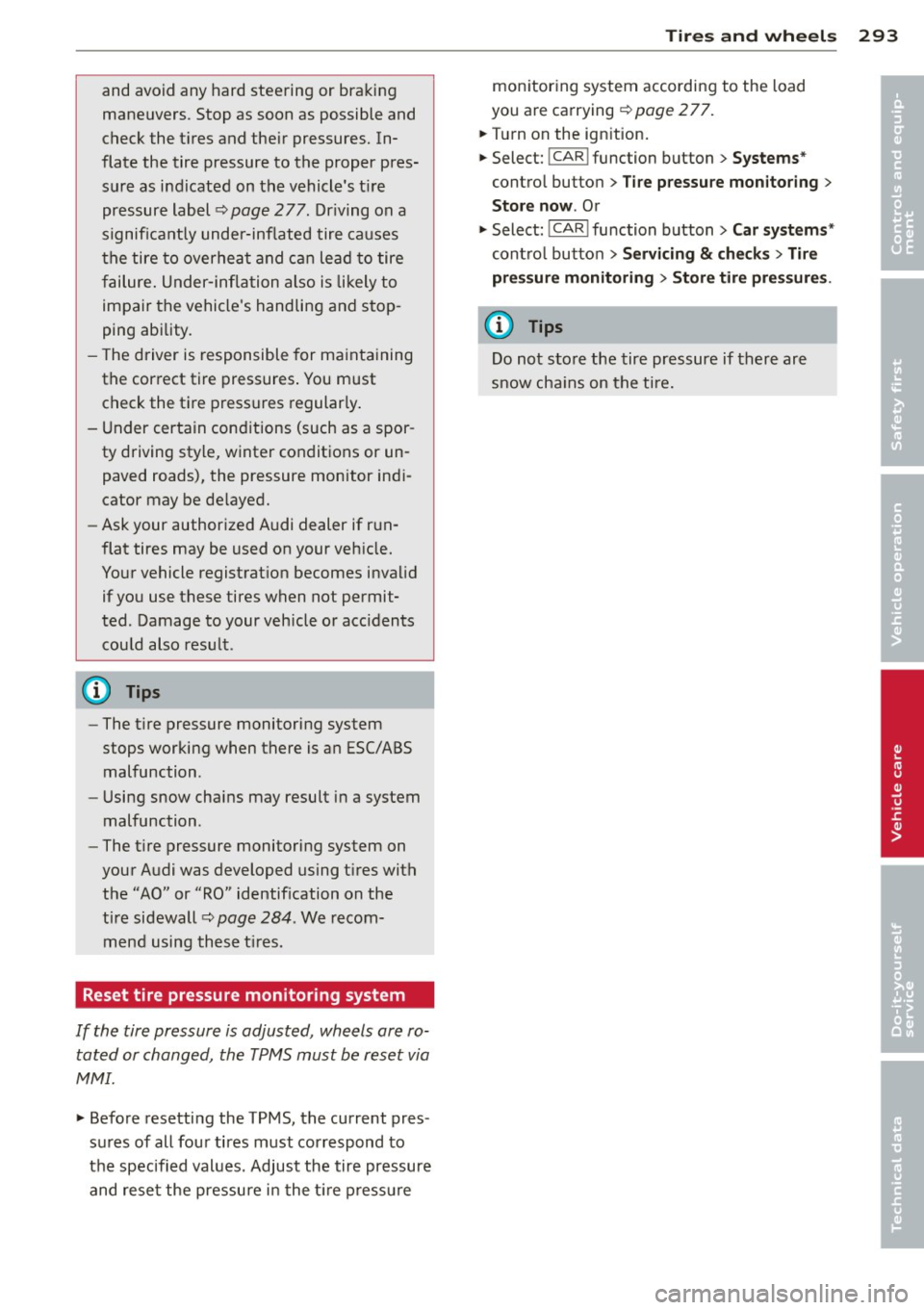
and avoid any hard steering or braking
maneuvers. Stop as soon as possible and
check the tires and their pressures. In·
flate the tire pressure to the proper pres
sure as indicated on the vehicle's tire
pressure label ¢
page 2 77. Driving on a
significantly under-inflated tire causes
the tire to overheat and can lead to tire
failure. Under-inflation also is likely to
impair the vehicle's handling and stop
ping ability.
- The driver is responsible for maintaining
the correct tire pressures. You must
check the tire pressures regularly.
- Under certain conditions (such as a spor
ty driving style, winter conditions or un
paved roads), the pressure monitor indi
cator may be delayed.
- Ask your authorized Audi dealer if run
flat tires may be used on your vehicle.
Your vehicle registration becomes invalid
if you use these tires when not permit
ted. Damage to your vehicle or accidents could also result.
@ Tips
- The tire pressure monitoring system
stops working when there is an ESC/ABS
malfunction.
- Using snow chains may result in a system
malfunction.
- The tire pressure monitoring system on
your Audi was developed using tires with
the "AO" or "RO" identification on the
tire sidewall¢
page 284. We recom
mend using these tires.
Reset tire pressure monitoring system
If the tire pressure is adjusted, wheels are ro tated or changed, the TPMS must be reset via
MMI.
.,. Before resetting the TPMS, the current pres
sures of all four tires must correspond to
the specified values. Adjust the tire pressure and reset the pressure in the tire pressure
Tires and wheels 293
monitoring system according to the load
you are carrying
¢ page 277.
.,. Turn on the ignition.
.,. Select:
!CAR I function button > Systems*
control button > Tire pressure monitoring >
Store now. Or
.,. Select:
!CAR I function button> Car systems*
control button > Servicing & checks > Tire
pressure monitoring
> Store tire pressures .
@ Tips
Do not store the tire pressure if there are
snow chains on the tire.
•
•
Page 297 of 340
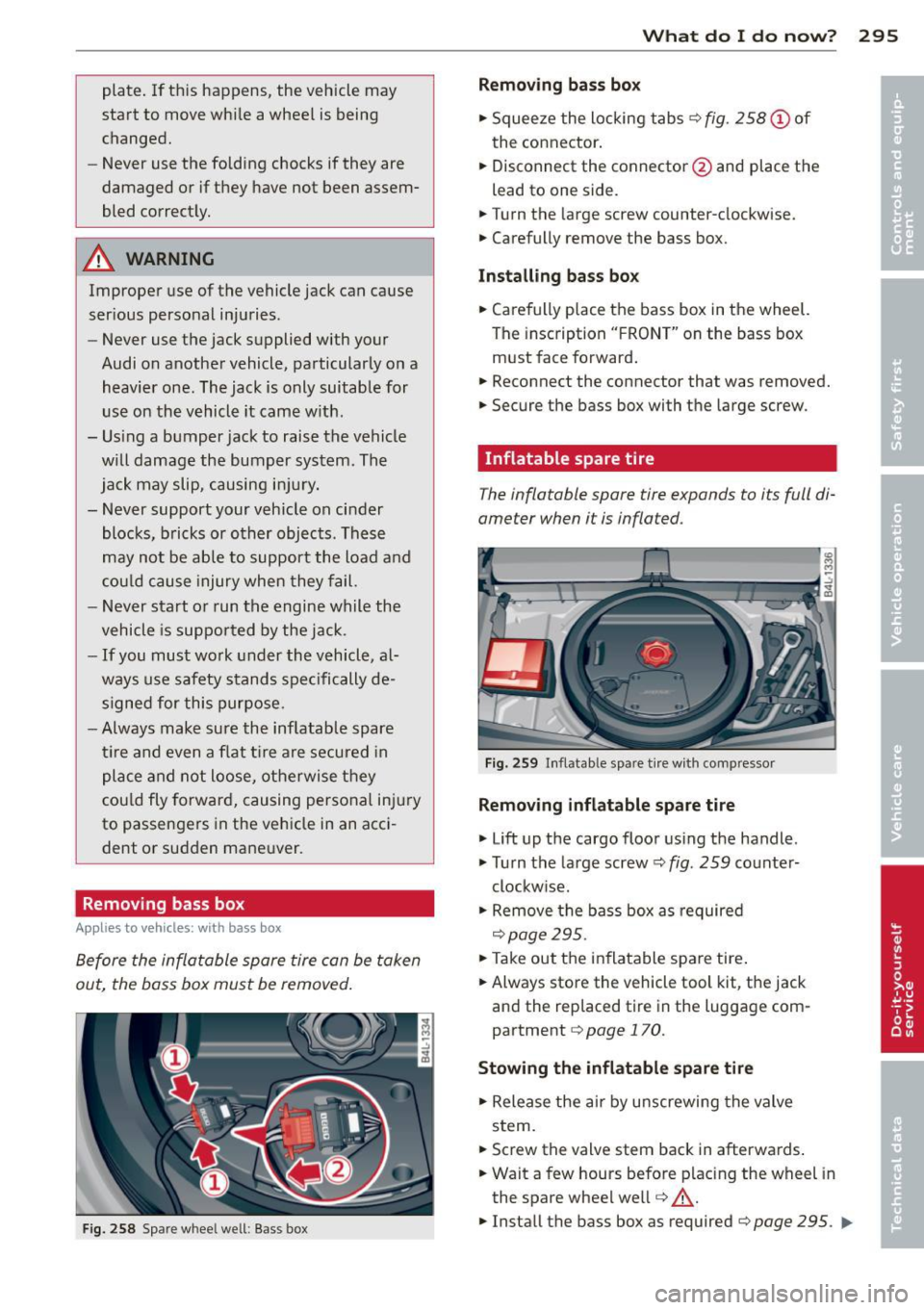
plate. If this hap pens , the vehicle may
start to m ove whi le a whee l is being
changed.
- Never use the folding chocks if they are
damaged or i f they have not been assem
bled correct ly.
A WARNING
Improper use of the vehicle jack can cause
ser ious personal injuries.
- Never use the jack supplied with your
Audi on another vehicle, particularly on a heavier one. The jack is only suitable for
use on the vehicle it came w ith .
- Us ing a bumper jack to raise the vehicle
will damage the bumper system. The
jack may slip, causing i njury.
- Never support your vehicle on cinder bloc ks, b ricks or other objects. Th ese
may not be able to support the load and
cou ld cause injury when they fail.
- Never start or run t he engine while the
vehicle is suppor ted by the jack.
- If you must wo rk under the vehicle, al
ways use safety stand s spe cifically de
signed for this purpose.
- Always make sure the inflatable spare
tir e a nd even a f lat t ire are se cured in
place and not loose, ot herwise they
cou ld fly forward, causing personal inj ury
to passengers in the veh icle in an acc i
dent or sudden mane uver.
Removing bass box
Applies to vehicles: with bass box
Before the inflatable spare tire can be taken
out, the bass box must be removed .
Fig . 2 58 Spare wheel well: Sass box
What do I do now ? 295
Removing bass box
.,. Squee ze the locking tabs ~ fig . 258 (D of
the conne ctor .
.,. Disconnect the connector @and place the
lead to one side.
.,. Turn the large screw counter-clockwise .
.,. Carefully remove the bass box.
Installing bass bo x
.,. Carefully p lace the bass box in the wheel.
The inscription "F RO NT" on the bass box
must face forward .
.,. Reconnect the connector that was removed.
.,. Secure the bass box with the large screw .
Inflatable spare tire
The inflatable spare tire expands to its full di
ameter when it is inflated.
Fig. 25 9 In flatable spare tir e w ith compressor
Removing inflatable spare tire
.,. Lift up the cargo floo r us ing the handle .
"' Turn the large screw
9 fig . 259 co unte r-
clockw ise.
"' Remove the bass box as required
¢ page 295 .
.,. Take out the in flatable spare tire .
.,. Always store the vehicle tool kit, the jack
and the replaced tire in the luggage com
partment
9 page 170.
Stowing the inflatable spare t ire
"' Release the ai r by u nscrewing the valve
stem .
.,. Screw the valve stem back in afterwards .
.,. Wait a few hours before p lac ing the wheel in
the spare wheel we ll¢ ,& .
"' Install the bass box as required ¢
page 295 . ..,_
Page 298 of 340
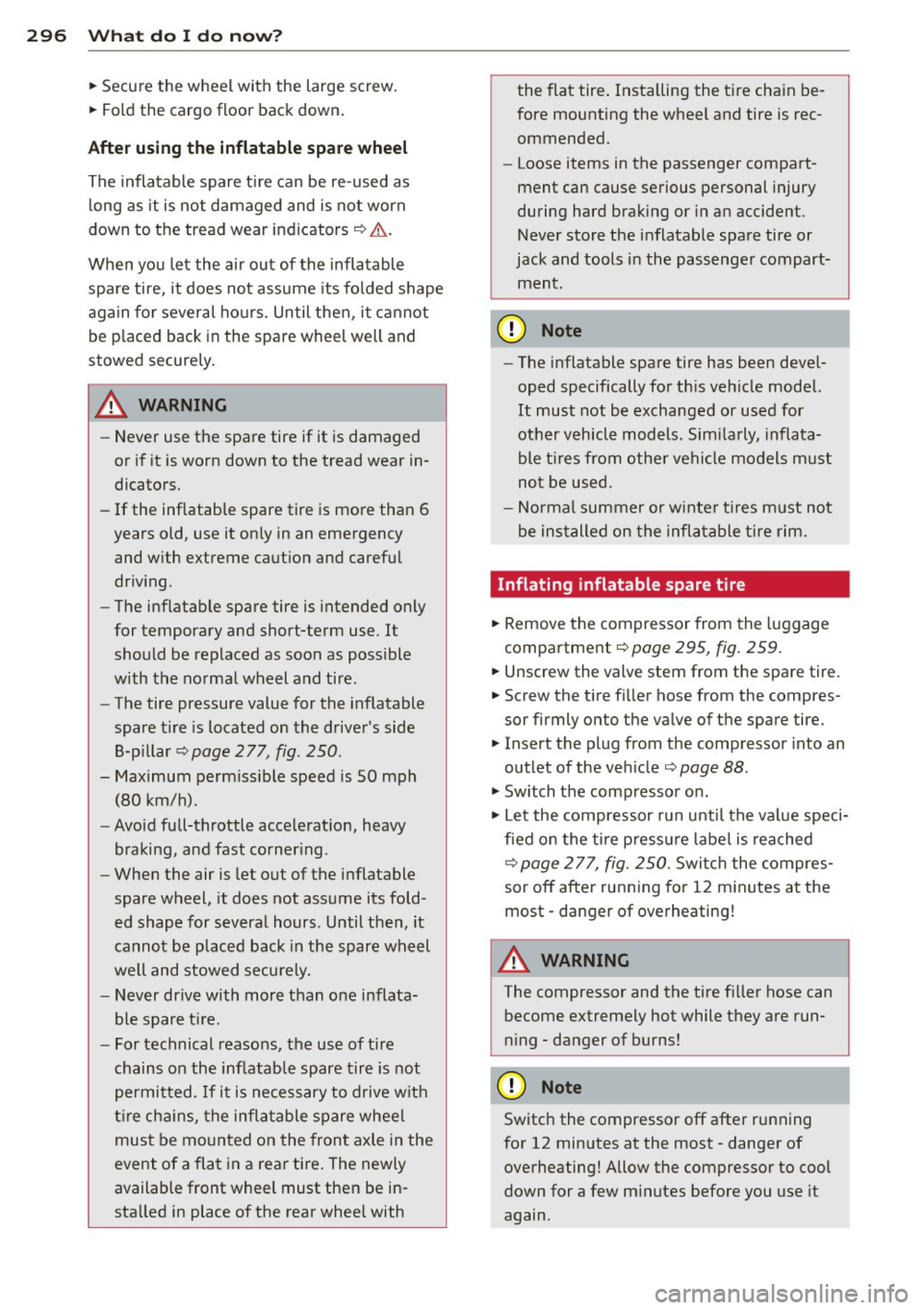
2 9 6 What do I do no w?
• Secure the wheel with the large screw.
• Fold the cargo floor back down .
After using th e inflat able spare wheel
The inflatable spare t ire can be re-used as
l ong as it is not damaged and is not worn
down to the tread wear indicators
c::> A .
When you let the air out of the inflatable
spa re tire, it does not assume its folded shape
again for several ho urs. Until then, it cannot
be p laced back in the spare wheel well and
stowed securely.
A WARNING
- Never use the spare tire if it is damaged
or if it is worn down to the tread wear in
dicators.
- If the inflatable spare tire is more than 6
years old, use it on ly in an emergency
and with extreme caut ion and careful
driv ing .
- The inflatable spare tire is intended only
for temporary and short-term use .
It
should be replaced as soon as possible
with the no rmal wheel and tire .
- The tire pressure value for the inflatable
spare t ire is located on the driver's side
B-p illar
c::> page 277, fig . 250.
-Maximum perm iss ible speed is SO mph
(80 km/h).
- Avoid full-throttle acce lerat ion, heavy
braking, and fast corner ing .
- When the air is let out of the inflatable
spare wheel, it does not assume its fold
ed shape for several hours . Until then, it
cannot be placed back in the spare wheel
we ll and stowed secu rely.
- Never drive with more than one inflata
ble spare ti re.
- For technical reasons, the use of tire
chains on the inf latable spare tire is not
permitted.
If i t is necessary to drive w ith
t ir e cha ins, the infla table spare wheel
must be mounted on the front axle in the
event of a flat in a rear tire . The newly
available front whee l must the n be in
sta lled in place of the rear wheel with the flat tire
. Insta lling the ti re cha in be
fore mounting the wheel and tire is rec
ommended.
- Loose items in the passenger compart
ment can cause serious personal injury
during hard brak ing or in an accident.
Never store the inflatable spare tire or
jack and tools in the passenge r compart
ment.
(D Note
- The inflatable spare tire has been deve l
oped specifically for th is veh icle model.
It must not be exchanged or used for
other vehicle models. Sim ila rly, inflata
ble t ires from other vehicle models m ust
no t be used.
- Norma l summer or w inte r ti res must not
be ins talled on the infla table t ire rim.
Inflating inflatable spare tire
• Remove the compressor from the luggage
compartment
c::> page 295 , fig. 259.
• Unscrew the valve stem from the spare tire.
• Screw the tire f iller hose from the compres
sor firmly onto the
valve of the spare tire.
• Insert the plug from the compressor into an
outlet of the ve hicle
c::> page 88 .
• Switch the comp ressor on .
• Let the compressor run unti l the va lue speci
fied on the ti re p ressu re label is reached
c::> page 2 77, fig. 250 . Switc h the compres
sor off after running for 12 m inutes at the
most -danger of overheating!
A WARNING
-The compressor and the tire f iller hose can
become extremely hot while they are run
n ing -danger of burns!
([) Note
Switch the compressor off after running
for 12 min utes at the most -danger of
overheating! Allow the compressor to cool
down for a few m inutes before you use it
again .
Page 326 of 340
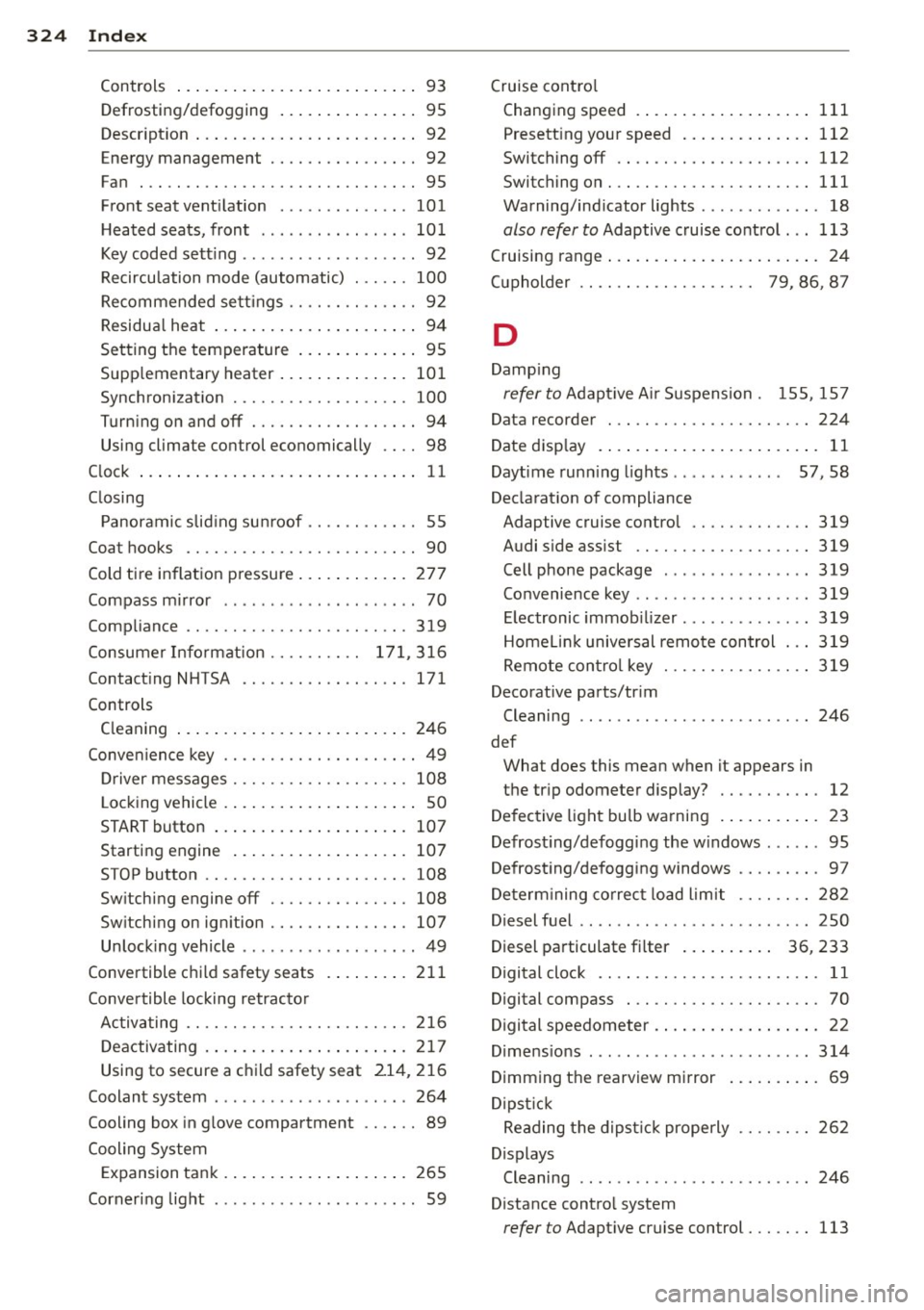
324 Index
Controls .... .. .. ..... ... .. .. .... .. 93
Defrosting/defogging . . . . . . . . . . . . . . . 95
Descr ipt ion .. .. ... .... ... .. .. .... .. 92
Energy management . . . . . . . . . . . . . . . . 92
Fan . .. .. .... ........... ........ .. 95
Front seat ventilation ...... ... .. ... 101
H eated seats, front ....... .. .. .. .. . 10 1
Key coded sett ing .............. ..... 92
Recircu lation mode (automatic) ... ... 100
Recommended se ttings .............. 92
Residua l heat ... ...... ... .. .. .... .. 94
Setting the temperature ... .. .. .... . . 95
Supp lementary heater ... .. .. ... ... . 101
Synchron izat ion ............ .. .... . 100
Turn ing on and off ........ .. .. .... .. 94
Using climate control economically . . . . 98
C lock ... .... ... . ...... ... .. .. .... .. 11
C losing
P anoramic slid ing su nroof .. .. .. .. .. . . 55
Coat hooks . . . . . . . . . . . . . . . . . . . . . . . . . 90
Cold ti re inflat ion p ressure ... .. .. .... . 27 7
Compass m irror ..... ...... .. .. .. .. .. 70
Comp liance .. ............. .. .. .. ... 319
Consumer Info rmation . . . . . . . . . . 1 71, 3 16
Contact ing NHTSA ...... .... ... .... . 171
Controls Cleaning ... ... .. ..... ... .. .. .... . 246
Conve nience key ..................... 49
Dr iver messages ........ .. .. .. .. .. . 108
L ock ing vehicle ... ..... ... .. .. .... .. 50
START button .. .. ..... ... .. .. .... . 10 7
Starting engine ....... ... .. .. .... . 107
STOP button ...................... 108
Sw itching engine off ............... 108
Sw itching on ignition .. ..... ..... .. . 107
Unlock ing vehicle .......... ... .. .... 49
Convertible c hil d safety seats . ... .. .. . 211
Conve rtible locking retracto r
Activating ........................ 216
Deactivating . . . . . . . . . . . . . . . . . . . . . . 217
Using to secure a chi ld safety seat 21 4, 2 16
Coolant system ................. .... 264
Cooling box in g love compartment .. .... 89
Cooling System Expansion tank . .. ..... ... .. .. .... . 265
Corner ing light .. .... ...... .. .. .. .. .. 59 Cruise cont
ro l
Changing speed .. .. ... ..... ... .. .. 111
Presett ing your speed .. ..... ... .. .. 112
Switching off ..................... 112
Switching on ..... ............. .... 111
Warning/ind icator lights ........... .. 18
also refer to Adaptive cruise control ... 113
Cruising range . . . . . . . . . . . . . . . . . . . . . . . 24
(upholder . . . . . . . . . . . . . . . . . . . 79 , 86, 8 7
D
Damp ing
refer to Adapt ive A ir Suspension . 155, 15 7
Data recorder ... .. ............. .. .. 224
Date d is p lay . . . . . . . . . . . . . . . . . . . . . . . . 11
Daytime run ning l ights... ....... .. 57, 58
Declarat ion of compliance
Adaptive cruise control ............. 319
Audi side ass ist ................... 319
Cell phone package . . . . . . . . . . . . . . . . 319
Convenience key .. .. ... ....... ... .. 319
E lectronic i mmob i Lizer . . . . . . . . . . . . . . 319
Homel in k universal remo te control ... 319
Remote contro l key ............ .... 319
Decorative parts/tr im
Cleaning ...... .................. . 246
def What does this mean when it appears in
the tr ip odometer display? ........... 12
De fective light bu lb warning . ... .. .. .. . 23
Defrost ing/defogg ing the w indows ... .. . 95
Defrost ing/defogging windows ......... 97
De term ining co rrect load limit ........ 282
Diesel fuel .. .. .. .. .. ... ....... ... .. 250
Diesel pa rticulate f ilter . . . . . . . . . . 36, 233
Digital cloc k . . . . . . . . . . . . . . . . . . . . . . . . 11
Digital compass . . . . . . . . . . . . . . . . . . . . . 70
Digital speedometer . . . . . . . . . . . . . . . . . . 22
Dime nsio ns .. ... ................... 314
Dimming the rearview mirror ... .. .. .. . 69
D ipst ick
Reading the d ipst ic k properly ........ 262
Displays Cleaning . . . . . . . . . . . . . . . . . . . . . . . . . 246
Distance control system
refer to Adapt ive cruise control ..... .. 113
Page 330 of 340
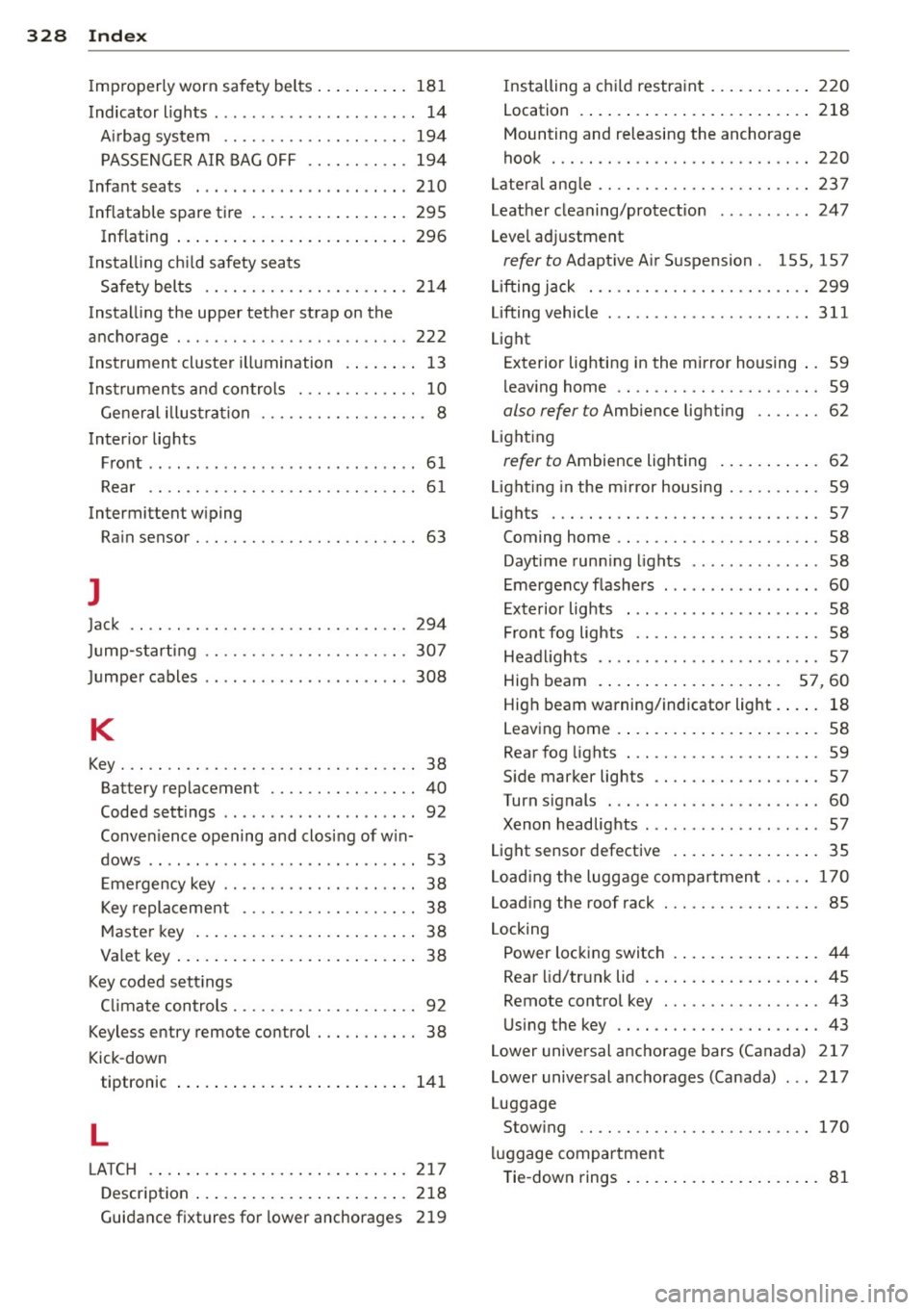
328 Index
Imp roperly worn safety be lts ... .. .... . 181
Indicator lights . . . . . . . . . . . . . . . . . . . . . . 14
A irbag system ........... .... .... . 194
PASSENG ER A IR BAG OFF .. .. .. .. .. . 194
Infant seats . . . . . . . . . . . . . . . . . . . . . . . 210
I nflatable spare tire ..... ... .. .. .... . 295
Inflating ... ... . ...... ... ... ..... . 296
I ns tal ling ch ild safety seats
Safety belts ........... .. .. .. .. .. . 214
Installing the upper tether strap on the
ancho rage ... ... .... .... .. .. .. .. .. . 222
Instrument cluster ill umination . ... .. . . 13
I ns truments and controls ... .. .. .... .. 10
General illustra tion ..... .. .. .. .. .. ... 8
Inter ior lights
Front .. .. .. ..... ........... ... .. .. 61
Rear .. .. .. .. . .......... .. .. .... .. 61
Intermittent w iping
Ra in sensor .............. .. .. .. .. .. 63
l
Jack .. .. .. .. ................. .... . 294
J ump-s tart ing .. ........... .. .. .. .. . 307
Jumper cables ................ ... .. . 308
K
Key . .. .. .. .. .. . .......... .. .. .... .. 38
Ba ttery replacement . . . . . . . . . . . . . . . . 40
Coded sett ings .............. ... .. .. 92
Conven ience opening and closing of w in-
dows .... ... .. .... .... .. .. .. .. .. .. 53
E mergency key . . . . . . . . . . . . . . . . . . . . . 38
Key replacement . . . . . . . . . . . . . . . . . . . 38
Master key . . . . . . . . . . . . . . . . . . . . . . . . 38
Valet key . . . . . . . . . . . . . . . . . . . . . . . . . . 38
Key coded sett ings
C lima te controls . . . . . . . . . . . . . . . . . . . . 9 2
Keyless entry remote control . .. .. .. .. . . 38
Kick -down
tiptronic ... .. . .. ..... ... .. .. .... . 14 1
L
LA T C H
D escription .. .. .. ..... ... .. .. .... .
Guidance fixt ures fo r lower anchorages 21
7
218
219 Installing a child restra
int .. ... ... . .. 220
Location . ..... .. ... .. ..... ... .. .. 218
Mounting and releasing the anchorage
hook . .... .... .. ............. .... 220
Latera l ang le .... .. ............. .... 237
Leather cleaning/protect ion ....... ... 24 7
Level adj ustment
refer to Adaptive Air Suspension . 155, 157
Lifting jack . .. .. .. ... .......... .. .. 299
Lifting vehicle ..... ................ . 311
Light Exterior lighting in the mirror housing .. 59
leav ing home .. .. ... .......... .. .. . 59
also refer to Amb ience light ing .. .. .. . 62
Lighting
refer to Ambience lighting . . . . . . . . . . . 62
Light ing in the m irror housing ..... .. .. . 59
Lights . .. .. .... .. ............. ..... 57
Coming home . . . . . . . . . . . . . . . . . . . . . . 58
Daytime runn ing lights ............ .. 58
Emergency flashe rs . . . . . . . . . . . . . . . . . 60
Exterior lights . . . . . . . . . . . . . . . . . . . . . 58
Front fog lights . . . . . . . . . . . . . . . . . . . . 58
Headl ights .. .. .. ... .......... .... . 57
High beam . . . . . . . . . . . . . . . . . . . . 57, 60
High beam warning/indicator light . ... . 18
Leaving home .... .. ... ..... ... .. .. . 58
Rear fog lights ... ............... .. . 59
S ide marker lights ............. ..... 57
Turn signals . ... . ... ... .... ... .. .. . 60
Xenon headlights . . . . . . . . . . . . . . . . . . . 5 7
Light sensor defective . .. ..... ... .. .. . 35
Load ing the luggage compartmen t ..... 170
Load ing the roof rack ............ .... . 85
Locking Power locking switc h ... ..... ... .. .. . 44
Rear lid/trunk lid ... .... .... ... .. .. . 45
Remote control key ............ .... . 43
U sing the key .. .. ............. .. .. . 43
Lower universal anchorage bars (Canada) 217
Lower unive rsal ancho rages (Canada) 217
Luggage Stow ing .. .... .. ... .......... .... 170
l uggage compa rtment
Tie-down rings ... .. ... ..... ... .. .. . 81
Page 336 of 340
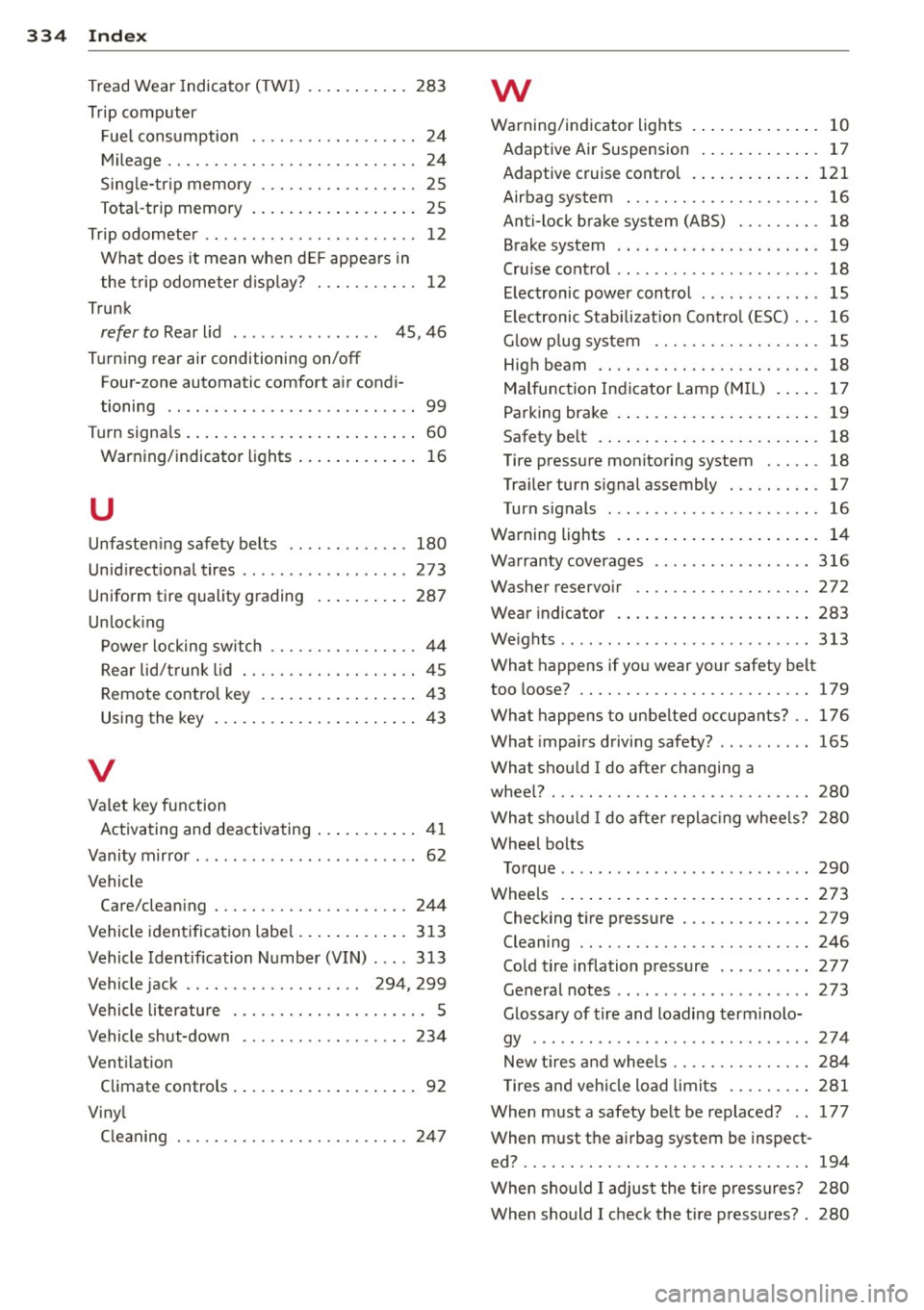
334 Index
Tread Wear Indicator (TWI) . ... .. .... . 283
Trip computer Fuel consumption . . . . . . . . . . . . . . . . . . 24
M ileage .... ............. .. .. .. .. .. 24
Sing le -tr ip memory ....... .. .. .... .. 25
Total -t rip memo ry . . . . . . . . . . . . . . . . . . 25
Trip odometer .............. ... .. ... . 12
What does it mean whe n dEF appears in
the t rip odomete r d isplay? . .. .. .... .. 12
Trunk
refer to Rear lid . . . . . . . . . . . . . . . . 45, 46
T u rn ing rear air conditioning on/off
Four -z one automatic comfort a ir condi-
tioning ...... ........... .. .. .... .. 99
T u rn signa ls . ... . .. ..... ... .. .. .... .. 60
Warning/indicator lights ... .. .. .... . . 16
u
Unfasten ing sa fe ty be lts
Unid irect iona l tires .......... ... .. .. .
Uniform ti re quality g rading ... .... .. .
Un lo ck ing 180
273
287
P owe r locking sw itch .... .. .. .. .. .. . . 44
Rear lid/trunk l id ......... .... .... .. 45
Remote control key . . . . . . . . . . . . . . . . . 4 3
Using the key . . . . . . . . . . . . . . . . . . . . . . 43
V
Va let key function
Activa ting and deactivating ... ... ... .. 41
Vanity m irror . . . . . . . . . . . . . . . . . . . . . . . . 62
Vehicle Care/clean ing ............ .. .. .... . 244
Vehicle ident ificat ion labe l ... .. .. .. .. . 3 13
Vehicle Identification N umber (VIN) ... . 313
Vehicle jack . . . . . . . . . . . . . . . . . . . 294, 299
Vehi cle liter ature . . . . . . . . . . . . . . . . . . . . . 5
Vehicle shut-down .......... ... .. .. . 234
Vent ilation
Climate controls . . . . . . . . . . . . . . . . . . . . 92
V in yl
C le a ning ... ... .......... .. .. .. .. . 247
w
Warning/ind ica tor lights . ..... .... . .. . 10
Adaptive Air Suspension . . . . . . . . . . . . . 17
Adaptive cruise control . ..... ... .. .. 121
Airbag system .................... . 16
Anti- lock brake system (ABS) . . . . . . . . . 18
Brake system ...... .... .... ... .. .. . 19
Cruise contro l . . . . . . . . . . . . . . . . . . . . . . 18
E lectronic power cont rol ... ...... ... . 15
El ectronic Stab ilization Contro l (ESC) .. . 16
G low p lug sys tem ............. .... . 15
Hig h beam .. .. .. ... .......... .. .. . 18
Malfunction Ind icator Lamp (M IL) .. .. . 17
Pa rking brake .... .. .... .... ... .. .. . 19
Safety be lt . . . . . . . . . . . . . . . . . . . . . . . . 18
Tire pressure monitoring system . . . . . . 18
Trail er turn s ignal assembly ... .. .... . 17
Turn signals ... .. ... .. .. ... ..... .. . 16
Warning lights . . . . . . . . . . . . . . . . . . . . . . 14
Wa rranty coverages .... ... ...... .. .. 316
Washer reservo ir .... ........... .. .. 272
Wea r indica to r .. .. .. .... .... ... .. .. 28 3
We ights ....... ... ................ . 313
What happens if yo u wear your safety belt
too loose? .. .... .. ............. .... 179
Wh at happens to unbelted o ccupants? .. 176
What impai rs driving safety? ....... ... 16S
What shou ld I do after changing a
whee l? . .... .... .. ................. 280
Wh at shou ld I do afte r repla cing whee ls? 280
Wheel bolts Torque ....... ... ................ . 290
Wheels . ... .... .. ... .. ..... .... . .. 273
Checking t ire pressure .......... .. .. 279
Cleaning .. .... .. ... .......... .... 246
Co ld tire inflation pressure .. ... ... .. 277
General notes .. .. .......... ...... . 273
G lossary of tire and loading terminolo-
gy ... .. .. .. .. .. ............... .. 274
New t ires and whee ls ........... .... 28 4
T ires and veh icle loa d limits ..... .... 281
When must a safety be lt be replaced? .. 177
When m ust the airbag system be inspect -
ed? .... .... .... .. ................. 194
When should I adjus t the tire pressures? 280
When should I check the tire press ures? . 280